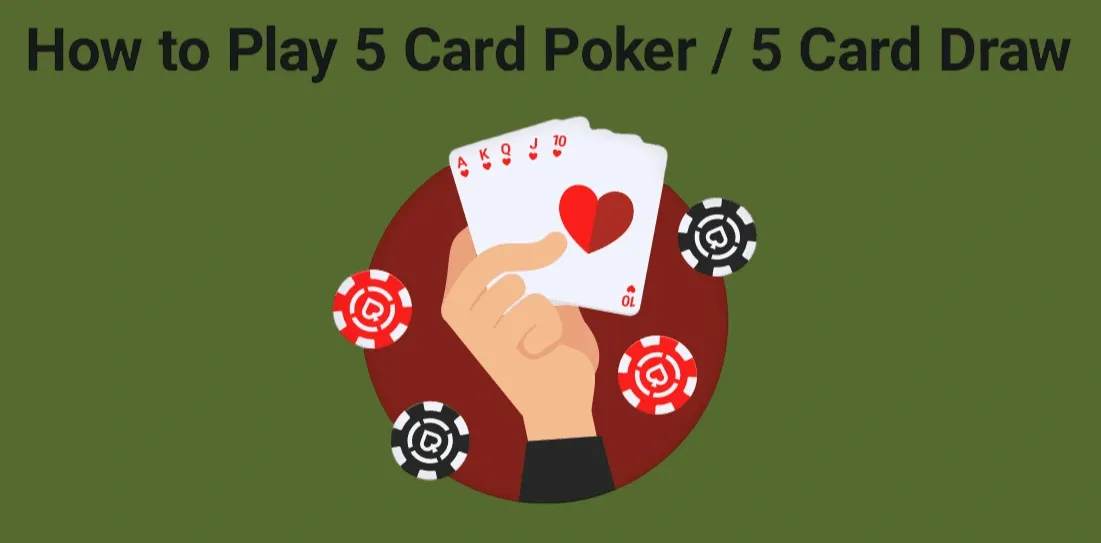5-Card Poker Rules: How to Master 5-Card Draw Poker

5 Card Draw is one of the easiest types of poker. For many players, it’s the first version of the game they learn.
It’s more popular in home games than in casinos and has mostly been replaced by games like Texas Hold’em and Omaha.
Still, many players around the world enjoy 5 Card Poker — especially online, where some poker sites offer both cash games and tournaments.
How to Play 5-Card Draw Poker: A Complete Guide

Understanding how to play 5 Card draw and hand rankings forms the cornerstone of successful 5-Card Draw play. The standard poker hand hierarchy includes:
- High card
- One pair
- Two pair
- Three-of-a-kind
- Straight
- Flush
- Full house
- Four-of-a-kind
- Straight flush
- Royal flush
Players can participate in three distinct betting structures:
- Fixed-limit
- Pot-limit
- No-limit
5 Card poker rules may be strict. Fixed-limit games restrict bet sizes to predetermined amounts, creating controlled action suitable for beginners. Pot-limit rules cap bets at the total amount in the pot. It makes the game exciting but still controlled. No-limit removes all betting restrictions, enabling aggressive players to wager their entire stack at any moment.
The game accommodates 2-7 players comfortably, though 6 players create optimal dynamics. Each round begins after players post blinds or antes, ensuring money enters every pot. This structure answers the question how to play 5 Card poker and guarantees action while maintaining strategic depth across all betting formats.
Understanding the Basics of Five-Card Draw Poker
5 Card stud poker is simple and easy for beginners to learn. Played with a full deck of 52 cards, it’s suited for 2 to 7 participants. But it works best with 5 or 6 players for a balanced game.
Each player receives five face-down cards after posting the required ante or blind bets. Unlike community card games, these five cards remain private throughout the entire hand. Players examine their cards and decide their initial strategy based solely on this information.
Here’s other poker 5 Card draw rules. The game has two betting rounds with a drawing phase in between. In the first round, players look at their cards and choose to fold, call, or raise. Then comes the drawing phase, where they can throw away unwanted cards and get new ones from the deck.
Key Elements:
- Ante or blind structure initiates each hand
- Two distinct betting rounds create action
- One drawing opportunity between betting rounds
- Private cards only - no community cards
The final betting phase begins right after the draw. This is the key moment where bluffing and reading your opponents really matter. Then, the remaining players show their cards, and the best hand wins the pot.
The simple rules of the Five Card stud poker let players focus on basic poker skills instead of tricky board situations.
If you're interested in exploring other poker variants, check out our guide on Short Deck Poker for a faster-paced twist on the classic game. For inspiration from the pros, discover the richest poker players and their incredible net worths in 2025.
Essential Strategies for 5-Card Draw Beginners

Starting hand awareness forms the foundation of solid 5-Card Draw play. That’s the way to understand how to play Five Card poker. Strong opening hands include pairs of jacks or higher, any two pair combination, and three-of-a-kind. Marginal hands like low pairs and ace-high require careful consideration based on position and opponent behavior.
Drawing decisions directly impact hand strength and pot odds. Keep all your cards when the hand is strong — like two pair or better. For single pairs, discard three cards to maximize improvement chances. Straight and flush draws present trickier situations - drawing one card offers better odds but reveals hand strength to observant opponents.
Position matters significantly:
- Early position requires stronger hands
- Late position allows more speculative play
- Button position provides maximum information
Bluffing opportunities arise frequently since opponents cannot see community cards at poker 5 card game type. Representing strong hands through confident betting and minimal draws often succeeds against tight players. However, avoid excessive bluffing against calling stations who rarely fold.
Bankroll management becomes crucial in 5-Card Draw. The drawing element creates variance, making proper bet sizing essential. Conservative players should avoid large pots without premium holdings, while aggressive players can exploit tight opponents through strategic pressure.
Reading opponents focuses on drawing patterns and betting behavior rather than physical tells.
Ready to play 5-Card Draw for real money? Explore the top platforms for an exciting poker experience: Best Poker Apps.
What Cards Should You Discard in 5-Card Draw?
Making correct discard decisions separates winning players from recreational ones. The drawing phase offers the only opportunity to improve hand strength, making these choices critical for long-term success.
Basic drawing strategy follows mathematical principles. Players should maximize their chances of improving while considering the information their draw reveals to opponents. Standing pat with weak hands can sometimes work as a bluff, but generally proves unprofitable against experienced players.
Basic Drawing Guidelines:
What you hold | What you should do |
| One pair | Draw three cards |
| Two pair | Draw one card |
| Three-of-a-kind | Draw two cards |
Straight and flush draws require special consideration. Open-ended straight draws offer eight outs and reasonable improvement odds. Inside straight draws provide only four outs and rarely justify chasing unless pot odds strongly favor the draw.
Four-card flush draws present decent opportunities, especially in late position against few opponents. Trying to complete a flush with one card usually gives around a 1 in 5 chance, or roughly 20% odds.
Keep kickers only in specific situations. Holding an ace alongside a small pair occasionally makes sense, but generally reducing the draw by one card improves hand odds significantly. Advanced players sometimes vary their drawing patterns to disguise hand strength and confuse opponents.
Mastering Advanced Strategies in 5-Card Draw Poker
Advanced 5 Card Draw strategy focuses on bluffing and reading opponents. Experienced players develop complex drawing patterns that disguise actual hand strength. Standing pat with marginal holdings like ace-high occasionally succeeds against multiple opponents who expect premium hands.
Range balancing becomes crucial at higher stakes. Smart players vary their actions across similar situations, preventing opponents from establishing reliable reads. Sometimes drawing two cards to trips instead of the standard two creates confusion and masks hand strength.
Psychological warfare elements:
- Timing tells reveal opponent confidence
- Betting patterns indicate hand strength
- Drawing decisions expose player tendencies
Bet sizing carries significant information in 5-Card Draw. Small bets often indicate drawing hands or bluffs, while large bets typically represent strong made hands. Skilled players exploit these tendencies by reversing their betting patterns at strategic moments.
Meta-game considerations influence long-term profitability. Building a tight image allows for profitable bluffs later in sessions. Conversely, loose players can exploit tight opponents by increasing aggression with marginal holdings.
Position exploitation reaches beyond basic concepts. Late position players can manipulate pot odds through strategic raises, forcing drawing hands to pay premium prices for their chances. Early position strength should focus on value extraction rather than deception for better odds of getting a royal flush in 5-card draw.
Top Online Site to Play 5-Card Draw Poker
1xBit.com stands out as a premier destination for 5-Card Draw enthusiasts seeking a modern poker experience. This cryptocurrency-focused platform earned recognition from Bitcoin.com as the "Best Crypto Betting Platform," demonstrating its commitment to excellence in digital gaming.
The registration process takes seconds rather than days. Players simply provide an email address and create a password - no identity verification, document uploads, or lengthy approval processes. This streamlined approach appeals to poker players who value privacy and immediate access to games.
Key advantages for poker players:
- Instant cryptocurrency deposits and withdrawals
- Complete anonymity protection
- 24/7 human customer support
- Mobile app compatibility
1xBit supports over 40 different cryptocurrencies, accommodating players regardless of their preferred digital currency. Bitcoin, Ethereum, Litecoin, and even newer tokens like Dogecoin receive full support, eliminating the need for multiple exchange conversions.
The platform uses top-level encryption and 2FA for better security. Cold wallet storage protects player funds from online threats while maintaining instant access for active gaming sessions.
The platform's mobile applications deliver full poker functionality across Android and iOS devices. Fingerprint login, push notifications, and optimized interfaces ensure seamless gameplay whether at home or traveling.
FAQ
Each round begins with blinds or antes. Every player gets five cards, then makes a first bet. After that, cards can be swapped for new ones. A second round of betting takes place. When multiple participants remain active, all holdings must be revealed. The strongest five-card hand takes the pot.
Poker combinations follow a hierarchical order from weakest to strongest as detailed: high card, single pair, dual pair, trio, sequential run, suited collection, full house, quartet, sequential suited run, and royal sequential suited combination. These hand values match what’s used in most other poker games. If two players have similar hands, the winner is decided by the highest card.
Players can discard and replace zero to five cards during the drawing phase. Most games limit draws to four cards maximum, keeping at least one original card. Standing pat means keeping all five cards. Drawing all five cards rarely occurs and often indicates a very weak starting hand.
Two betting rounds occur: pre-draw and post-draw. First round happens after dealing initial cards. Drawing phase follows the first betting round. Second betting round begins after all players complete their draws. Final showdown reveals hands among the remaining players.

Sergey Ilyin
An experienced specialist in the field of betting and gambling. He analyzes market trends, player behavior, and the dynamics of online gaming platform development. An expert in the intricacies of sports betting and knowledgeable about the regulatory framework of the gambling industry.
